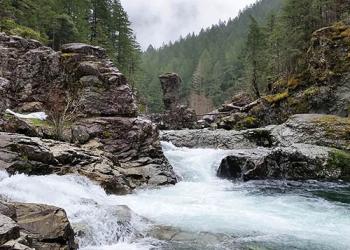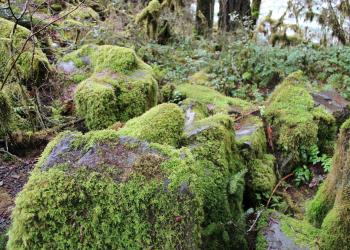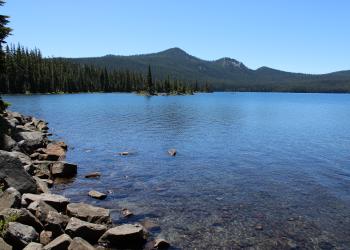Wilderness
The Willamette National Forest has eight wildernesses which total 380,805 acres. These areas, the majority of which encompass seven major mountain peaks in the Cascades, are popular with hikers, backpackers, and mountain climbers.
The Wilderness Act of 1964 defines Wilderness as “an area where the earth and its community of life are untrammeled by man, where man himself is a visitor who does not remain.” The Act’s purpose is to preserve and protect the natural ecosystems and wild areas and also provide opportunities for solitude and retrospective or primitive recreation.
Wilderness: Know Before You Go
Visitors need a Central Cascades Wilderness Permit or a self-issuing permit, depending on the trip. There are two types of entry permits required between June 15 and October 15 for entering all wildernesses in the Willamette National Forest.
Central Cascades Wilderness Permits
Central Cascades Wilderness Permits are required for all overnight use and 19 day-use trailheads in the Mt. Jefferson, Mt. Washington, and Three Sisters Wilderness areas between June 15 and October 15. The permit system has been implemented to allow access into these well-loved wildernesses, but also to protect them for future generations.
Permits can be reserved on Recreation.gov beginning the first Tuesday of April every year. For day-use in these wildernesses on the 60 trails that do not require a permit, visitors will need to obtain a free self-issued permit at those trailheads.
Free Self-Issued Permit
Unless a Central Cascade Wilderness Permit is required, all other visitors who enter Willamette National Forest wilderness areas will need a free self-issued wilderness permit. A permit is necessary June 15-Oct. 15 for each group entering the wilderness. Self-issue permits are free and available at wilderness trailheads.
Do Not Drink Untreated Water!
Only water from developed recreation sites is safe to drink. Open water sources are easily contaminated by human or animal waste. Water from springs, lakes, ponds, and streams should not be used without proper treatment.
Hunting And Fishing
The Wilderness is home to many game animals, including deer and elk, and to many fish. State of Oregon game regulations apply.
Mountain Climbing
Some peaks are difficult to climb and should not be attempted casually. Check with a Forest Service office about conditions and suggested routes. (Conditions and route information is not available for all wildernesses at Forest Service offices).
Weather
High-altitude weather can change very quickly. Even during good weather, mountain temperatures are always cooler, particularly at night. Several layers are usually better than one heavy layer of clothing.
Fire Danger
Do not smoke while hiking or riding. Stop at a safe place to smoke, then carefully extinguish before leaving. Do not leave fires burning or smoldering unattended. Put them dead out before you leave.
What To Do If Lost
Keep calm. Do not walk aimlessly. Trust your map and compass. Shelter and warmth are much more important than food.
- To find your position, climb to a place where you can see the surrounding country.
- When you reach a road, trail, or telephone line, follow it. As a last resort, follow a stream downhill.
- Before being caught by darkness, select a sheltered spot and prepare camp, shelter, and firewood. Stay in this camp all night.
- If you are injured and alone, keep calm. Stay where you are, clear an area down to mineral soil and build a signal fire. Green boughs will create heavy smoke.
- Three signals of any kind, either audible or visible, is the universal SOS call. Examples are three blasts from a whistle, three regulated puffs of smoke , or three flashes from a mirror or flashlight. Repeat at regular intervals. If it is recognized by a search party, it will be answered by two signals. Use it only when in need of help.
- Notify the County Sheriff's office or a Forest Service office if a member of your party is believed to be lost or in trouble.
- Travel prepared with matches, map and compass, space blanket, whistle, food.
Leave No Trace
It has been written that "even the most careful camper leaves the mark of this passage on the land". Whatever the evidence you leave behind contributes to making wilderness a little less wild. Ideally, when you leave the wilderness you should leave nothing behind and take nothing away other than photographs and memories. Practice Leave No Trace principles.
Federal Regulations (36 CFR 261.18) for National Forest Wilderness
Motorized equipment and equipment used for mechanical transport is prohibited. This includes the use of motor vehicles, motorboats, motorized equipment, bicycles, hang gliders, wagons, carts, portage wheels, and the landing of aircraft including helicopters. Flying drones or unmanned aircraft systems (UAS) over wilderness areas is also prohibited.
The following are prohibited in all congressionally designated wilderness areas managed by the Deschutes and Willamette National Forests:
- Groups larger than 12 persons and 12 head of stock. Large groups multiply the impact on the resource and can be disruptive to others.
- Entering or being in Willamette National Forest wildernesses without a permit. Visitors need a Central Cascades Wilderness Permit or a self-issuing permit, depending on the trip. Information gathered from permits is vital in determining proper management.
- Hitching, tethering, picketing, or securing any pack or saddle stock within 200 feet slope distance of any permanent lake, stream, spring, pond or shelter. These areas are sensitive to the effect of repeated grazing and trampling. Once damage occurs, water quality may be affected by resulting erosion.
- Motorized equipment and mechanized equipment such as bicycles, wagons, carts or wheelbarrows (except wheelchairs). These uses are incompatible with the legal and ethical definition of wilderness.
- Discharging a firearm within 150 yards of a campsite or occupied area or across a body of water or in any manner or place whereby any person is exposed to injury. The indiscriminate discharge of firearms in areas of recreation use is dangerous.
- Camping or being within areas posted as closed for rehabilitation. These areas have been closed to allow recovery. Use of these sites inhibits restoration efforts.
- Cutting or damaging any live tree or vegetation except as authorized. Damaging or cutting live trees or shrubs is opposed to wilderness values and the concept of a natural environment.
- Storing equipment, personal property or supplies within the wilderness for more than 48 hours. Storing personal belongings disrupts the natural conditions of the wilderness and others' experience.
- Gathering a forest product, for example mushrooms and berries, except for personal on site use. Limiting collection of edibles, such as mushrooms and berries, to what you can consume during your visit assures future visitors the same sense of discovery and enjoyment.
- Commercial use and/or services within wilderness except by special use permit. This use is incompatible with the legal and ethical definition of Wilderness.
Violation of these and other laws, rules and regulations which apply to designated Wilderness are punishable by a fine or imprisonment. (16 U.S.C. 551, 18 U.S.C. 3559 and 3571).
The Waldo Lake Area has some special regulations in place to preserve this uniquely peaceful and beautiful setting and to protect the lake and shoreline.
What are the rules?
- Generator and chainsaw use are prohibited in undeveloped areas around Waldo Lake.
- Boat motor use is restricted to electric motors only; 10 m.p.h. or less.
- Floatplanes are prohibited.
Other Area Regulations
- 14 day boat moorage limit. People must be staying at Waldo Lake while mooring their boats.
- Islands are day use only, no overnight camping or campfires.
Three Sisters Wilderness
- These areas require a Central Cascade Wilderness Permit for overnight use and some day use.
- Green Lakes basin, Moraine Lake basin, North and South Matthieu Lakes are designated camping areas and overnight campers must camp within 15 feet from an established post. If no campsites are available, campers must leave the lake basin.
- No Name Lake on Broken Top Tarn – No camping within ¼ mile of the high-water mark.
- Golden Lake – No camping within 250 feet of water or the high-water mark
- No camping within 100 feet of the high-water mark of lake or any water source in these areas:
- Linton Meadow area
- Minnie Scott Springs area
- Obsidian area, including
- Arrowhead Lake
- Glacier Creek
- Obsidian Creek
- Obsidian Meadows
- White Branch Creek
- Campfires are prohibited above 5,700 feet
Mt. Jefferson Wilderness Regulations
- These areas require a Central Cascade Wilderness Permit for overnight use and some day use.
- Pamelia Lake and Jefferson Park Area – No camping within 100 feet of high-water mark of lake or any other water source
- Campfires are prohibited above 5,700 feet and within these lake basins:
- Marion Lake
- Ann Lake
- Table Lake
Mt. Washington Wilderness Regulations
- These areas require a Central Cascade Wilderness Permit for overnight use and some day use.
- Campfires are prohibited above 5,700 feet and within these lake basins:
- Benson Lake
- Tenas Lake
Diamond Peak Wilderness
- Campfires are prohibited above 6,000 foot elevation.
Check with a local Ranger Station for further information and detailed maps.
Violation of these and other laws, rules and regulations which apply to designated Wilderness are punishable by a fine or imprisonment. (16 U.S.C. 551, 18 U.S.C. 3559 and 3571).
As part of a larger effort to reduce invasive species on national forest lands, weed-free feed is required in the 17 national forests and the Crooked River National Grasslands of the Pacific Northwest.










